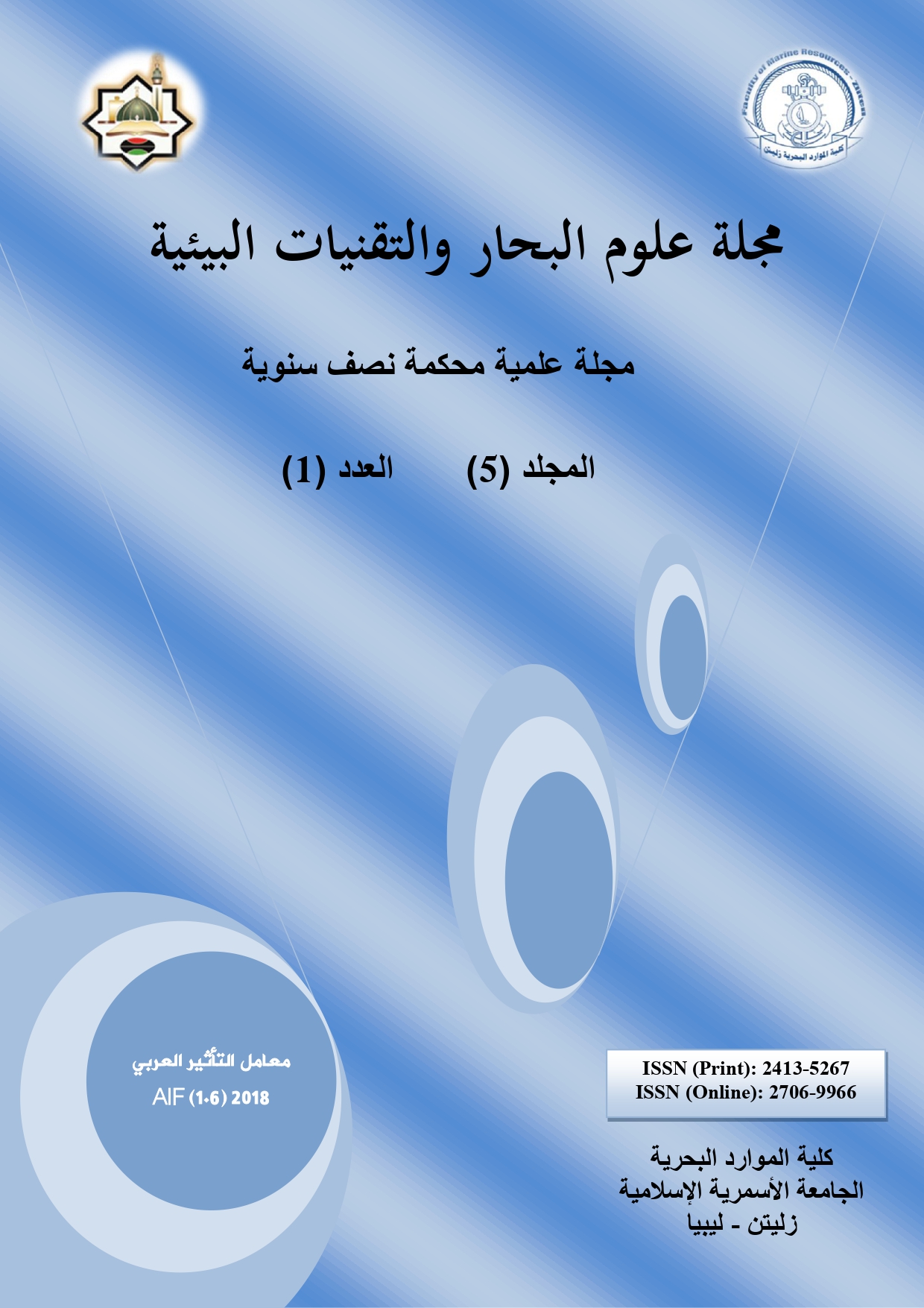مجموعة التجوية الفيزيائية الانفصالية المؤثرة على مواد صخور البناء بمدينة صبراتة الأثرية، شمال غرب ليبيا
DOI:
https://doi.org/10.59743/jmset.v5i1.70الكلمات المفتاحية:
مجموعة التجوية الفيزيائية الانفصالية، تجوية مواد الصخور بمدينة صبراتة الأثرية، التجوية الفيزيائية المؤثرة على أحجار البناء الأثريةالملخص
تُعد مدينة صبراتة الأثرية ضمن الإرث العالمي لليونيسكو (UNESCO World Heritage) والواقعة على ساحل البحر المتوسط، غرب العاصمة طرابلس بالشمال الليبي. وكمثيلتها بالمدن الأثرية الأخرى في العالم، فقد تم بناءها باستخدام الأحجار الصخرية المتكونة طبيعيا فهي بالتالي تتعرض باستمرار لعوامل التعرية التي تتحكم فيها قوانين الطبيعة محدثة بها أضرارا على درجات مختلفة من الشدة. يعد التفاعل ما بين مواد صخور الأبنية الأثرية وعوامل التعرية الطبيعية المسئول عن نوع الأضرار الناتجة وكذلك درجة شدة انتشارها. وكنتيجة للوعي المتزايد والاحترام تجاه المباني الأثرية فان حمايتها من كل الأضرار أصبح شأن كبير عند كل من ساسة الدول والشعوب. يناقش البحث الحالي أشكال التعرية الفيزيائية الرئيسية والتابعة للمجموعة الثالثة المعروفة بالانفصال "Detachment Group" أحد مجاميع التعرية التي ابتكرها (Fitzner and Heinrichs, 2002, 2004). اعتمدت طريقة البحث على استخدام نماذج معدة بواسطة Fitzner و Heinrichs والتي من شأنها إظهار وتقدير أضرار التجوية الانفصالية الفاعلة على مواد صخور بناء مدينة صبراتة الأثرية. تم رصد تسع أشكال رئيسية للتجوية الانفصالية متضمنة ما يقارب خمسة عشر شكلا لإشكال التجوية المؤثرة والتي تؤثر على صخور مواد البناء للمدينة محدثة أضرارا بمباني المدينة تراوحت درجة شدتها ما بين الضرر غير واضح والضرر المعتدل. ولتسهيل عملية تتبع هذه الأضرار في المدينة، تم إنشاء خمسة عشر خارطة كنتورية لكل ضرر من أشكال التجوية المؤثرة موضحا عليها درجة شدة الضرر ومدى انتشارها في كل نواحي المدينة. ولإظهار إجمالي تأثير هذه الأضرار المرصودة على أبنية المدينة، تم تقدير دليلي التدهور الخطي والتقدمي لإشكال التجوية وتم إنشاء خريطة كنتورية لكل منهما. يتوقع أن التغيرات اليومية والفصلية لدرجة الحرارة وكذلك التقلبات التي تطرأ على الرطوبة النسبية للجو بالإضافة الى عمليات التبلور الملحي فوق أسطح الأبنية ونسبة البلل أو محتوى الماء المحصور في مواد صخور الأبنية، كلها عوامل بإمكانها إحداث أضرارا لهذا النوع من التجوية. تم رفع توصيات تضمنت الدعوة إلى استكمال دراسة بقية أنواع التجوية المؤثرة على أبنية مدينة صبراتة الأثرية وكذلك دعوة المسؤولين في الدولة لحماية أبنية المدينة من الانهيار نتيجة لأضرار التجوية.
المراجع
Agence France-Press (January 31,2017). Libyan coastguard, (The Nation).
April Report (2016). Ancient ruins in danger of erosion damage. Available online at: [Wikipedia.org./wiki/Sabratha, 2019].
Calvaruso C., Turpault M.P., and Frey-Klett P. (2006). Root-associated bacteria contribute to mineral weathering and to mineral nutrition in trees: a budgeting analysis. Appl. Environ. Microbiol., 72(2): 1258-1266.
El Hinnawy, and Cheshitev, (1975). Explanatory Booklet for geological map of Libya (1:250,000, Sheet Tarabulus NI33-13. Geological Mapping Division, Industrial Research Center, Tripoli, Libya.
Fitzner B., Heinrichs K., and La Bouchardiere D. (2000). Damage index for stone monuments. Proceedings of the 5th International Symposium on the Conservation of Monuments in the Mediterranean Basin, 5-8 April, Seville, Spain.
Fitzner B., Heinrichs K., and La Bouchardiere D. (2002). Limestone weathering of historical monuments in Cairo, Egypt. Geological Society, London, Special Publications, 205(1): 217-239.
Fitzner B., and Heinrichs K. (2004). Photo atlas of weathering forms on stone monuments. Available online at: [http://www.stone.rwth-aachen.de].
Decret F. (2011). Early Christinity in North Africa. James Clarke & Co Ltd., UK.
Goudie A.S., and Viles H. (2008). Weathering Processes and Forms. In Burt T.P., Chorley R.J., Brunsden D., Cox N.J., and Goudie A.S.; Quaternary and Recent Processes and Forms. Landforms or the Development of Geomorphology. Geological Society of London. pp. 129–164.
Heinrichs K., and Fitzner B. (1999). Comprehensive characterization and rating of the weathering state of rock carved monuments in Petra/Jordan: weathering forms, damage categories and damage index. Annual of the Department of Antiquities of Jordan, 43: 321-351.
Shushan I.F., Akhmyra S.B., and Minas H.A. (2019). Evaluation of physical weathering damages acting on stone building materials of Sabratha monuments, North west Libya. Journal of Academic Researches, 13: 345-357 (Published in Arabic).
Mark J.J. (2019). Ancient History Encyclopedia, Sabratha. Available online at: [https://www.ancient-.eu/Sabratha/].
National Geographic Society, (1996-2019). Available online at: [https://www.nationalgeographic.org/]
Gore Pamela J.W. (2013). Weathering at the "Wayback Machine". Georgia Perimeter College, Georgia State University, USA.
Sha'biyat of Great Jamahiriya (2009). Accessed (20 July 2009), (In Arabic).
Uroz S., Calvaruso C., Turpault M.P., and Frey-Klett P. (2009). Mineral weathering by bacteria: ecology, actors and mechanisms. Trends in microbiology, 17(8): 378-387.
Zambell C.B., Adams J.M., Gorring M.L., and Schwartzman D.W. (2012). Effect of lichen colonization on chemical weathering of hornblende granite as estimated by aqueous elemental flux. Chemical Geology, 291: 166-174.
التنزيلات
منشور
إصدار
القسم
الرخصة
الحقوق الفكرية (c) 2019 مجلة علوم البحار والتقنيات البيئية

هذا العمل مرخص بموجب Creative Commons Attribution 4.0 International License.









